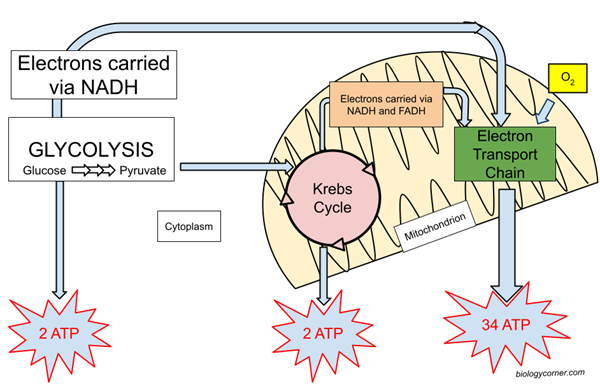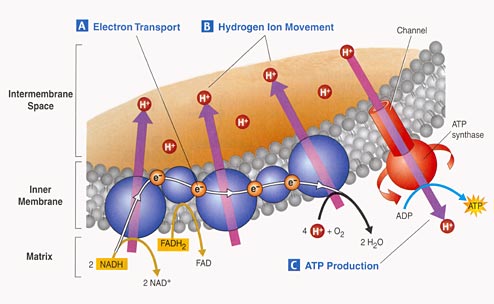Cellular Respiration and Electron Transport Chain
Cellular respiration is the process by which cells break down organic molecules, typically glucose, to produce usable energy in the form of adenosine triphosphate (ATP). This process occurs in three main stages: glycolysis, the citric acid cycle (also known as the Krebs cycle), and oxidative phosphorylation (including the electron transport chain).
Cellular respiration is a set of metabolic reactions that take place within cells to convert nutrients, such as glucose, into energy in the form of adenosine triphosphate (ATP). It occurs in three main stages: glycolysis, the citric acid cycle (also known as the Krebs cycle), and oxidative phosphorylation (including the electron transport chain).
C6H12O6 + 6O2 -->6 CO2 + 6H2O + 36 ATP
glucose + oxygen --> carbon dioxide + water + ATP

1.Glycolysis:
This is the first step of cellular respiration and occurs in the cytoplasm of the cell. During glycolysis, a molecule of glucose is broken down into two molecules of pyruvate. This process also generates a small amount of ATP and NADH (nicotinamide adenine dinucleotide), which carries high-energy electrons
a) 6 carbon glucose is split into two 3 carbon pyruvates
b) anaerobic - proceeds whether or not O2 is present ; O2 is not required
d) net yield of 2 ATP per glucose molecule
e) net yield of 2 NADH per glucose ---> sent to the ETC in mitochondria
The pyruvic acid diffuses into the inner compartment of the mitochondrion where a transition reaction occurs that serves to prepare pyruvic acid for entry into the next stage of respiration, this converts them an acetyl CoA which enters the Kreb's cycle.
If oxygen is not present, pyruvate is converted to lactic acid in the cytoplasm -- anaerobic respiration
2. Citric Acid or Krebs Cycle
The pyruvate molecules produced during glycolysis enter the mitochondria, where they undergo further oxidation in the citric acid cycle. This cycle generates more ATP, NADH, and another electron carrier called FADH2 (flavin adenine dinucleotide).
a)occurs in the inner mitochondrial matrix
b)
an aerobic process;
will proceed only in the presence of O2
c)
net yield of 2 ATP per glucose
molecule
d) net yield of 6 NADH and
2 FADH2 (NAD+ is reduced to NADH, FAD+ is reduced to FADH)
e) in this stage of cellular
respiration, the oxidation of glucose to CO2 is completed.
See Graphic on Citric Acid Cycle
3. Electron Transport System:
This is the final stage of cellular respiration and occurs in the inner mitochondrial membrane. During oxidative phosphorylation, the high-energy electrons carried by NADH and FADH2 are passed along a series of protein complexes known as the electron transport chain. As electrons move through the chain, they release energy, which is used to pump protons (H⁺ ions) across the inner mitochondrial membrane, creating an electrochemical gradient. This gradient drives the synthesis of ATP from adenosine diphosphate (ADP) and inorganic phosphate through a process called chemiosmosis.

a) consists of a series of
enzymes on the inner mitochondrial membrane
b) electrons are released from NADH and from FADH2 and as they are passed along the series
of enzymes, they give up energy which is used to fuel a process called chemiosmosis, which drives the process of ATP
synthesis using an enzyme called ATPase.
c)
net yield of 32 ATP per
glucose molecule
d)
6 H2O are formed
when the electrons unite with O2* at the end
of electron transport chain.
Cellular respiration produces a much larger amount of ATP compared to glycolysis alone. In eukaryotic cells, the majority of ATP is generated through oxidative phosphorylation in the mitochondria, although some ATP is also produced during glycolysis in the cytoplasm. ATP is the primary energy currency of cells and is used to power various cellular processes, including muscle contraction, active transport of molecules across cell membranes, and synthesis of macromolecules.
